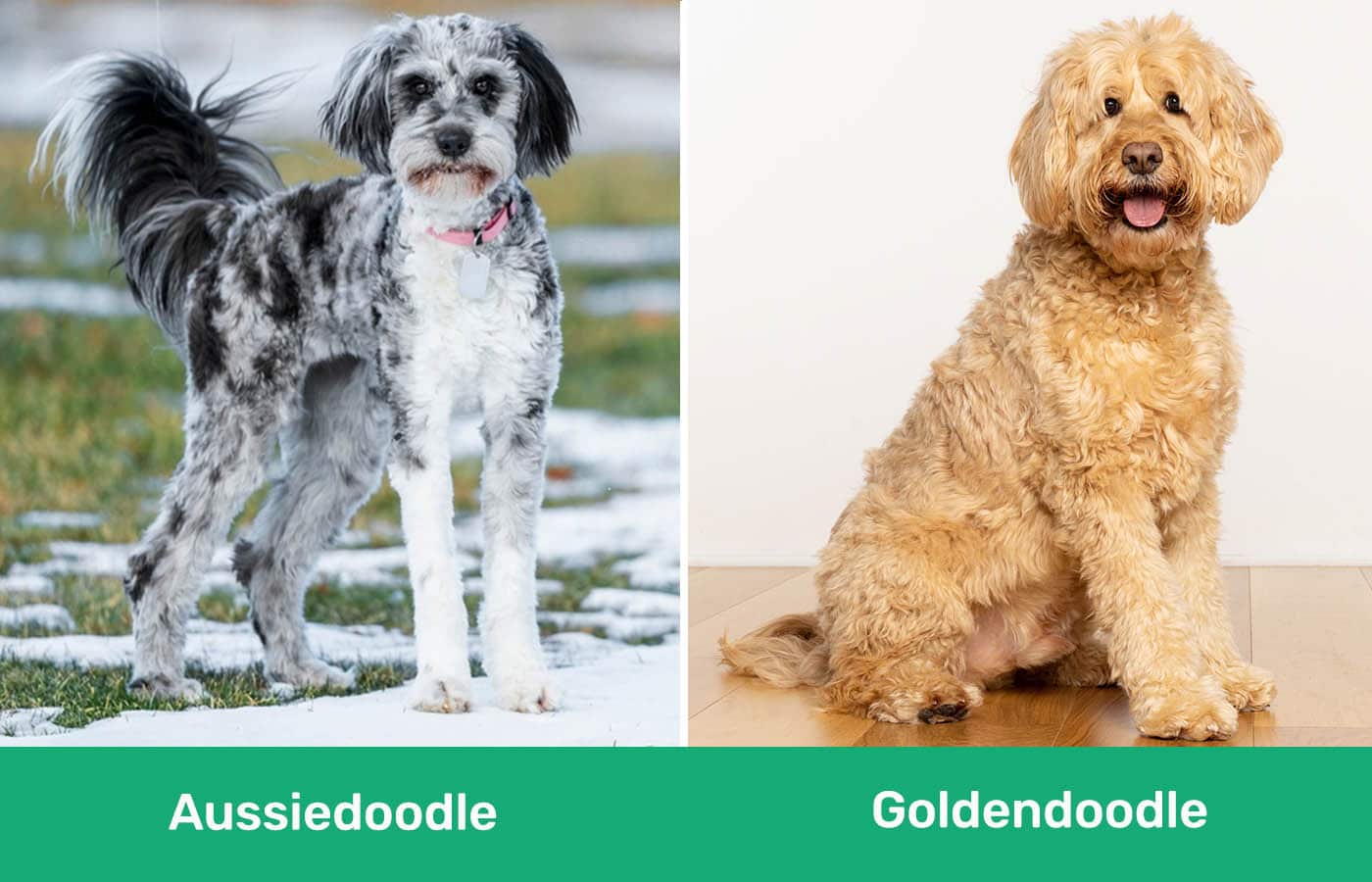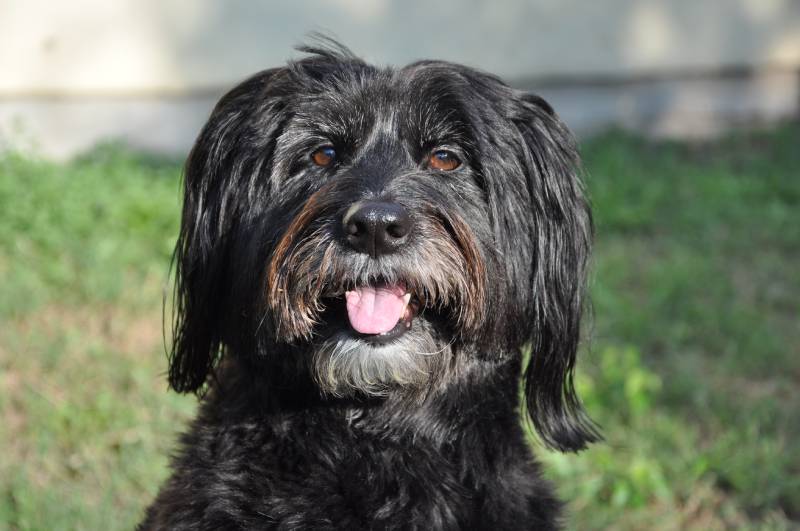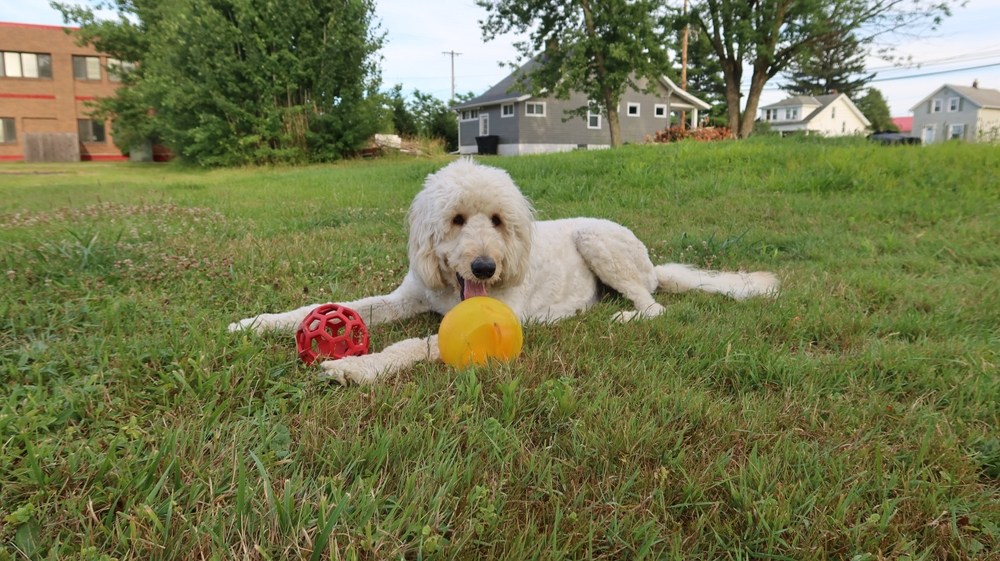Click to Skip Ahead
You’ve decided that you would love to add a Doodle to your household, but there are so many varieties out there! It’s definitely a challenge to determine which breed is right for you.
It can help narrow things down if you are fond of specific breeds. If you happen to be a fan of the Australian Shepherd and the Golden Retriever, we will take a more detailed look here at the Aussiedoodle and Goldendoodle, two popular mixed breeds.
When you compare and contrast the breeds like this, it might just make your decision easier (or harder, as the case may be!).
Visual Differences

At a Glance
- Average height (adult): 10–20 inches
- Average weight (adult): 10–70 pounds
- Lifespan: 12–16 years
- Exercise: 90–120 minutes a day
- Grooming needs: Moderate
- Family-friendly: Yes
- Other pet-friendly: Yes
- Trainability: Intelligent, loyal, eager to please, focused
- Average height (adult): 8–21+ inches
- Average weight (adult): 7–90 pounds
- Lifespan: 12–15 years
- Exercise: 60–90 minutes a day
- Grooming needs: Moderate
- Family-friendly: Yes
- Other pet-friendly: Yes
- Trainability: Intelligent, eager, goofy
Aussiedoodle Overview

The Aussiedoodle (also called the Aussiepoo) is the offspring of the Australian Shepherd and the Poodle. The Poodle comes in three sizes: toy, miniature, and standard. So, the size of the Doodle depends on which size of Poodle was bred.
In fact, everything about the Aussiedoodle depends on which parent they take after most, including their appearance, temperament, and behavior. All of this also hinges on if the parents are purebred Poodles and Australian Shepherds or if the puppies come directly from a line of Aussiedoodles.
Personality / Character
Both the Aussie and Poodle are active dogs, so it’s a guarantee that the Aussiedoodle will be quite energetic. They are loyal to their families, but this can also lead to separation anxiety if they are left alone too long and too often.
They get along well with other pets and children, particularly if they are socialized well, but the Australian Shepherd side is prone to herding. This means they will sometimes attempt to herd your children and pets. But they are smart, playful, and a joy to have around!
Training
Training Aussiepoos can be fairly straightforward. Since they are smart and loyal, they are eager to please. The Aussie side tends to be quite focused, so the Aussiepoo can pick up on training quickly.
Training your Aussiedoodle is essential, or they will become unmanageable and destructive. All of that energy needs to go somewhere! Like all dogs, they need socialization starting at a young age.

Exercise
When you have a breed that is as high energy as this one, you must ensure that they receive the appropriate kind and amount.
You’ll want to aim for a minimum of about 90 minutes of exercise for an Aussiedoodle every day. This includes two to three walks in addition to allowing them to run off-leash when possible. They can make excellent hiking companions too.
Health & Care
Caring for an Aussiedoodle includes grooming them, and how often they are groomed depends on the coat that they inherit. The Poodle and Australian Shepherd have different coat types. Poodles have curly coats that don’t shed often but must be consistently trimmed.
Australian Shepherds have double coats that are long and wavy and don’t need that much trimming. So, an Aussiedoodle will likely have a wavy or curly coat that will require occasional trimming. They will also need brushing several times a week, and you’ll need to brush their teeth and trim their nails.
As far as health issues are concerned, mixed breeds aren’t as prone to inherited genetic conditions as their purebred parents are. But you should be familiar with the respective common conditions of the Australian Shepherd and Poodle to help you better understand your Aussiedoodle.
- Hip dysplasia
- Hypothyroidism
- Luxating patella
- Epilepsy
- Cataracts
- Skin allergies
A condition like hip dysplasia tends to affect large breed dogs, so if your Aussiedoodle is a small dog, they won’t be as likely to inherit it.

Suitable For:
Aussiedoodles are excellent family dogs, but if you have young children, they might try herding and chasing them. If you’re looking for a dog that’s easy to train, Aussiepoos might be perfect for you because they are smart and quick learners. The Aussiedoodle is also a great choice if you enjoy spirited activity in the great outdoors.
If you’re concerned about appearance, the Aussiedoodle will likely be multi-colored and not too large in size. Of course, this ultimately depends on the size of their Poodle parent.
Goldendoodle Overview

The Goldendoodle, like the Aussiedoodle, relies on the size of their Poodle parent in order to determine their overall size. While they are more likely to be larger than the Aussiedoodle, this does depend on whether the Goldendoodle’s Poodle parent was a miniature.
The Poodle can also contribute any number of colors to the Goldendoodle, but since the Golden Retriever typically comes in shades ranging from cream to deep gold, Goldendoodles tend to take on one of these shades.
Personality / Character
Goldendoodles are renowned for their loving and friendly personalities. They are incredible family dogs, and their energy and playfulness make them wonderful with children and other pets.
Goldendoodles are loyal and affectionate dogs, though unfortunately, separation anxiety can be a common issue with this breed.
Training
Training Goldendoodles can be quite easy, given their intelligence and eager-to-please temperament. But the Golden Retriever in them can make them act like a goofball at times, so you might need extra patience during training sessions. Socialization is crucial to raising a happy and well-adjusted dog.

Exercise
Poodles are high-energy dogs and so are Golden Retrievers. That said, while they’re larger than the Australian Shepherd, Golden Retrievers don’t need as much exercise. You should aim for no less than 60 minutes of exercise daily.
You can break this down into several walks, playtime, and off-leash running. Goldendoodles must receive this kind of exercise every day to meet their physical and mental requirements.
Health & Care
Grooming the Goldendoodle definitely takes a while. Golden Retrievers are double-coated like Australian Shepherds and are known to be shedders, so plenty of brushing is necessary.
If the coat is quite curly, it might not shed that much, but it will still need constant maintenance. The looser the curls, the more the dog will shed. As such, plenty of brushing is necessary.
Health conditions of a Goldendoodle might include:
- Hip dysplasia
- Subvalvular aortic stenosis
- Sebaceous adenitis
- Addison’s disease
- Bloat

Suitable For:
The Goldendoodle is perfect for people with children or for single people. If you’re looking for an excellent family dog, the Goldendoodle would be an ideal fit, especially if you love going for walks and being in the great outdoors. If you’re looking for a large dog that’s super playful and a bit goofy, you shouldn’t look much further than the Goldendoodle.
Which Breed Is Right for You?
The similarities between the Aussiedoodle and Goldendoodle are notable: They are both intelligent, trainable, and loving breeds. But there are a few distinctions that can make a difference for you.
Aussiedoodles tend to be easier to train because they can be more focused, intense, and energetic than the Goldendoodle. If you have children, you’ll likely do better with the Goldendoodle, as they will love your children and almost everyone else they meet.
Grooming is more or less the same between the two, but the Goldendoodle will likely shed more and will need more brushing. Keep in mind that if you’re looking for a hypoallergenic dog, there really isn’t such a thing, so you’re not guaranteed an allergy-friendly dog if you own a Doodle.
Still, both breeds are gorgeous, affectionate, and lively dogs, and you can’t go wrong with either!
Featured Image Credit: (L) IK Photography, Shutterstock | (R) Rena Schild, Shutterstock












